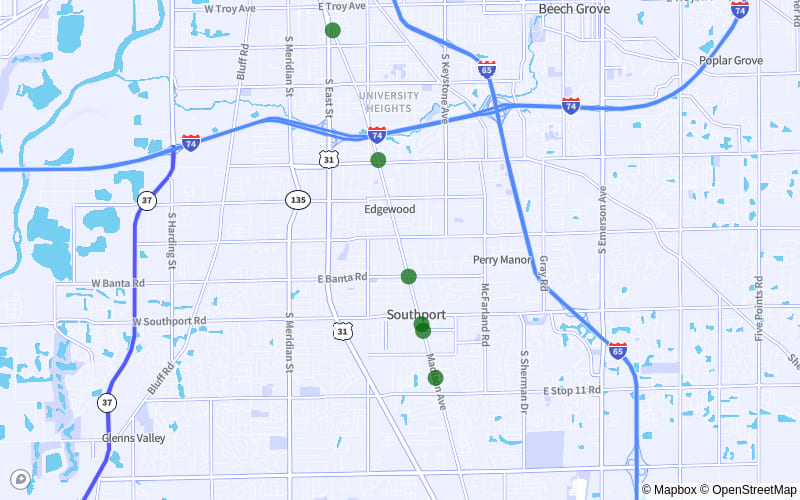Indiana Fatal Accident Study:
Indiana’s Deadliest Roads and Fatal Accident Statistics
MoneyGeek analyzed the 2,342 fatal accidents in Indiana between 2018 and 2020 to determine which roads were deadliest. We also explored the different factors that contributed to these incidents.
 DC
DCDoug Milnes, CFA
Head of Credit Cards at MoneyGeek
Doug Milnes is a CFA charter holder with over 10 years of experience in corporate finance and the Head of Credit Cards at MoneyGeek. Formerly, he performed valuations for Duff and Phelps and financial planning and analysis for various companies. His analysis has been cited by U.S. News and World Report, The Hill, the Los Angeles Times, The New York Times and many other outlets. Milnes holds a master’s degree in data science from Northwestern University. He geeks out on helping people feel on top of their credit card use, from managing debt to optimizing rewards.
 DC
DCDoug Milnes, CFA
Head of Credit Cards at MoneyGeek
Doug Milnes is a CFA charter holder with over 10 years of experience in corporate finance and the Head of Credit Cards at MoneyGeek. Formerly, he performed valuations for Duff and Phelps and financial planning and analysis for various companies. His analysis has been cited by U.S. News and World Report, The Hill, the Los Angeles Times, The New York Times and many other outlets. Milnes holds a master’s degree in data science from Northwestern University. He geeks out on helping people feel on top of their credit card use, from managing debt to optimizing rewards.
Updated: September 10, 2022
Advertising & Editorial Disclosure

MoneyGeek’s analysis of the 2,342 fatal crashes in Indiana from 2018 to 2020 identified the deadliest stretches in the state. Out of Indiana’s 202,707 miles of road, our study included 1,169 roads.
Several factors contributed to fatal accidents in the Hoosier State. These include hazardous driving behaviors — like drunk driving, speeding and distracted driving — and time of year.
Our analysis also dived into the data for Indiana’s counties, allowing us to identify the deadliest road in each.
Key Findings
- 38th St. from N. Hawthorne Ln. to Cornelius Ave. is the deadliest stretch of road in Indiana. Between 2018–2020, 10 fatal accidents occurred here.
- Speeding or drunk driving contributed to 42.4% of fatal accidents. Speeding was involved in 23.8% (557) of deadly crashes, while drunk driving was a factor in 18.6% (435) crashes.
- Only 4.3% of fatal crashes involved distracted driving. With 101 reported incidents, Indiana ranked better than 78% of states for distracted driving fatalities in MoneyGeek’s distracted driving study.
- October had the most deadly accidents between 2018–2020. There were 243 recorded incidents, accounting for 10.4% of all fatal crashes. September (235) and July (233) had the next highest numbers, respectively.
- Marion County had the highest number of deadly crashes of any county. The majority of these accidents happened on 38th Street.
10 Deadliest Road Stretches in Indiana
- DEADLIEST ROAD IN INDIANA38th St. from N. Hawthorne Ln. to Cornelius Ave.Indianapolis

- Fatal Accidents:10
- fatalities:11
- Crashes Per Mile:2.1
- distance:4.7 miles
- I-80 W from Exit 9 to Exit 3Hammond | Gary

- Fatal Accidents:8
- fatalities:8
- Crashes Per Mile:1.8
- distance:4.4 miles
- Madison Ave. from E. Murry St. to Lisa Walk Dr.Homecroft | Indianapolis

- Fatal Accidents:6
- fatalities:7
- Crashes Per Mile:1.3
- distance:4.7 miles
- Shadeland Ave. from E. 21st St. to Mill View Dr.Lawrence | Indianapolis

- Fatal Accidents:6
- fatalities:6
- Crashes Per Mile:2.2
- distance:2.8 miles
- E. 21st St. from N. Audubon Rd. to Snead Cir.Indianapolis

- Fatal Accidents:5
- fatalities:6
- Crashes Per Mile:1.0
- distance:4.8 miles
- I-65 from Exit 9 to Exit 5Clarksville | Jeffersonville | Sellersburg

- Fatal Accidents:5
- fatalities:5
- Crashes Per Mile:1.1
- distance:4.5 miles
- E. 30th St. from Bavarian Dr. to N. Bolton Ave.Indianapolis

- Fatal Accidents:5
- fatalities:5
- Crashes Per Mile:1.2
- distance:4.3 miles
- IN-130 W from Tower Rd. to W. 600 N.Valparaiso

- Fatal Accidents:4
- fatalities:6
- Crashes Per Mile:0.8
- distance:4.8 miles
- I-69 N from Exit 311B to Exit 316Fort Wayne

- Fatal Accidents:4
- fatalities:5
- Crashes Per Mile:0.9
- distance:4.5 miles
- W. Dunes Hwy. from Furnessville Rd. to N. Mineral Springs Rd.Chesterton | Porter

- Fatal Accidents:4
- fatalities:5
- Crashes Per Mile:1.4
- distance:2.9 miles
Drunk Driving Involved in 18.6% of Fatal Accidents
Drunk driving contributed to 30% of all U.S. traffic fatalities in 2020. Out of the 2,342 fatal accidents in Indiana between 2018 and 2020, about 18.6% involved alcohol-impaired drivers. That translates to 435 collisions resulting in death.
Alcohol can severely affect your driving abilities. Although you’re not legally drunk until your blood alcohol concentration (BAC) reaches 0.08%, a lower BAC still puts you and your passengers in danger.
Two alcoholic drinks usually increase your BAC to 0.02%, which puts you in a more relaxed state. Unfortunately, it also makes multitasking and tracking moving targets difficult — both of which are crucial for safe driving.
The cost of drunk driving can be considerable and long-term — even when it doesn’t cause a fatal accident. Besides paying fines, you may lose driving privileges and possibly face some jail time if you’re caught. A DUI on your record makes finding cheap car insurance in Indiana challenging because insurers consider you a high-risk driver. You’ll need to carry an SR-22 in Indiana, which is more expensive than other types of auto insurance coverage.
Speeding Is a Factor in 23.8% of Fatal Crashes
From 2018–2020, speeding contributed to 557 fatal accidents. That's 23.8% of all deadly crashes in Indiana during these three years.
Driving above the posted speed limit has considerably dangerous effects. You're more likely to lose control of your vehicle or need more stopping distance. These factors increase your chances of getting into a crash. It also makes your car's safety features less effective, leading to more severe injuries or, in worst-case scenarios, death.
Distracted Driving Contributed to 4.3% of Fatal Accidents
Driving requires your complete focus, and having distractions increases the likelihood of getting into a collision. From 2018 to 2020, there were 101 reported incidents of deadly crashes involving distracted driving in Indiana.
Indiana fares better than many states due to its lower distracted driving rates. Based on MoneyGeek's distracted driving study, it ranks as safer than 78% of other states.
In July 2020, Indiana enacted a Hands-Free Law that doesn't allow drivers to hold mobile devices while behind the wheel.
October Had More Fatal Accidents Than Any Other Month
MoneyGeek's analysis explored when fatal accidents were more likely to happen during the year.
Our findings showed that October recorded the highest number of deadly crashes (243) from 2018 to 2020. That's 10.4% of all accidents resulting in death in Indiana.
September and July had the following highest numbers of crashes. Each had 235 and 233 deadly accidents, respectively.
Driving Safely Protects You, Others and Your Wallet
Being a safe driver comes with multiple benefits. Not only do you help keep Indiana's roadways safer, but you'll also save more money in the long term. However, no matter how cautiously you drive, sometimes there's no avoiding an accident. That's what makes having full coverage car insurance essential; it gives you and your passenger more protection after a collision.
The average cost of auto insurance in Indiana is $725 per year. However, your premium may change depending on where you live. For example, car insurance in Indianapolis — the state's most populous city — costs around $759 a year. In comparison, you'll only spend about $670 for auto insurance in Fort Wayne.
Remember that these are only average rates. You may get a different figure once you start gathering lender quotes. Insurers consider your profile when calculating your premiums. These include factors such as your age and driving history. Don't forget to compare estimates — it's an excellent strategy to find the cheapest car insurance company for you.
Fatal Accidents and Most Dangerous Roads: County Breakdown
The top five counties with the highest number of deadly crashes contribute to 722 incidents. That is 31% of all fatal accidents in Indiana between 2018 and 2020.
At 339, Marion County had the highest number of deadly accidents. Most of these crashes happened along 38th street and involved speeding or drunk driving.
Methodology
MoneyGeek analyzed data from the National Highway Traffic Safety Administration Fatal Accident Reporting System (FARS) database using fatality data from 2018, 2019 and 2020. Currently, 2020 is the latest data available in the system.
About Doug Milnes, CFA

Doug Milnes is a CFA charter holder with over 10 years of experience in corporate finance and the Head of Credit Cards at MoneyGeek. Formerly, he performed valuations for Duff and Phelps and financial planning and analysis for various companies. His analysis has been cited by U.S. News and World Report, The Hill, the Los Angeles Times, The New York Times and many other outlets.
Milnes holds a master’s degree in data science from Northwestern University. He geeks out on helping people feel on top of their credit card use, from managing debt to optimizing rewards.
sources
- Federal Highway Administration. "Highway Statistics Series." Accessed November 1, 2021.
- In.Gov. "Indiana Is Hands-Free." Accessed August 27, 2022.
- National Highway Safety Administration. "2020 Traffic Safety Facts." Accessed August 27, 2022.
- National Highway Safety Administration. "Fatal Accident and Reporting System (FARS)." Accessed March 3, 2022.











